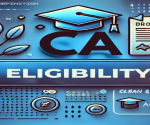The CA course is one of the toughest yet most rewarding professional qualifications in commerce, accounting, and finance. It is provided by the Institute of Chartered Accountants of India and gets students geared to become the perfect financial specialists who can do just about any work- from audits, tax consultant advice, and designing financial strategies to being strategic advisers. The Chartered Accountant (CA) syllabus has the following format: Foundation contains 4 subjects- Accounting, Law, Mathematics, and Economics. Intermediate comprises 8 subjects split into two groups – Group 1 consists of Accounting, Corporate Laws, Costing, and Taxation, and Group 2 consists of Advanced Accounting, Auditing, EIS-SM, and FM-Eco. Final has 8 subjects divided into two groups – Group 1 includes Financial Reporting, SFM, Audit, and Corporate Laws, while Group 2 includes SCM-PE, Risk Management, FSCM, and International Taxation.
Chartered Accountant Syllabus
The Chartered Accountancy course is divided into three exam levels. Each level is designed to enhance a candidate’s knowledge and skills. The CA Foundation level helps candidates gain basic concepts of accounting and commerce. The second level, CA Intermediate, covers subjects such as tax, corporate law, and cost accounting. Finally, CA Final involves advanced knowledge in financial management, auditin,g and international taxation.
CA Foundation Syllabus
The CA Foundation course is an entry-level course in the Chartered Accountancy curriculum for students passing Class 12. Its objective is to provide basic knowledge in accounting, law, mathematics, and economics. Four sheets have 100 digits each. Two are subjective. The other two are objective types. The basic CA exam pattern and sub-topics are as follows:-
| Paper | Marks | Type of Exam | Weightage | Key Subtopics |
| Principles and Practice of Accounting | 100 | Subjective | 25% | Accounting principles and process |
| Preparation of financial statements | ||||
| Rectification of errors | ||||
| Depreciation accounting, Bills of exchange | ||||
| Business Laws and Business Correspondence | 100 | Subjective | 25% | Indian Contract Act, 1872 |
| Sale of Goods Act, 1930 | ||||
| Business correspondence (emails, letters, and reports) | ||||
| Business Mathematics, Logical Reasoning, and Statistics | 100 | Objective | 25% | Percentages, Ratios, Profit and Loss |
| Logical reasoning puzzles and seating arrangements | ||||
| Statistics: Correlation, Index numbers, and Probability | ||||
| Business Economics and Commercial Knowledge | 100 | Objective | 25% | Demand, Supply, Price Elasticity |
| Market structures (Perfect and Imperfect competition) | ||||
| Introduction to business organizations and commercial knowledge |
CA Intermediate Syllabus
The second level in the Chartered Accountancy syllabus is CA Intermediate and this step follows the Foundation level knowledge acquisition. The Chartered Accountancy syllabus consists of eight papers in two groups. To pass the final stage which is CA Final, students have to clear both batches. At this level, you will get more detailed knowledge about accounting, corporate law, taxes, cost accounting. and auditing of accounts
CA Intermediate Group 1 Detailed Description
The four major subjects making up the core group provide the foundation for advanced financial and corporate decisions for students. These areas deal with complicated accounting rules, legal frameworks, cost analysis, and taxation systems that comprise the basics of knowledge in this field.
1. Accounting (Paper 1): The first report is accounting. It provides an in-depth introduction to financial reporting. and prepares students to face accounting challenges in practice. The objective is to build a sound foundation in accounting concepts, techniques, and principles.
2. Corporate and Other Laws Paper 2: Another document is company law and other laws. Students will be introduced to the legal framework that governs business and commerce in India. This article consists of two parts:
- Part A: Corporate Laws (60 marks): Refers to the Companies Act 2013 which deals with provisions for the establishment, management, and meeting of the board of directors. and compliance with company regulations
- Part B: Other Laws (40 marks): It covers the general rules. Some of these laws include: the Indian Contract Act of 1872, the Negotiable Instruments Act of 1881, and the Limited Liability Partnerships (LLP) Act of 2008.
3. Cost and Management Accounting (Paper 3): Cost and management accounting deals with cost management. Budgeting concepts and performance evaluation including other methods and tools This topic helps students cost their activities effectively. Allocate resources to the organization efficiently and make price and investment decisions based on cost. It is also a must for anyone working in the financial planning or expense management field.
4. Taxation Paper 4: This tax document is a complete study of taxes in India. It consists of two parts: direct tax law and indirect tax law.
- Section A: Direct Taxes (Income Tax) (60 marks): Calculating individual, corporate, and corporate income taxes, exemptions, deductions, and exemptions. Income tax refund and TDS requirements
- Section B: Indirect Taxes (GST) (40 marks): GST concepts such as investment tax credits Tax assessment, GST registration, GST payment, and tax filing
| Subject | Chapters | Weightage |
| Accounting | Framework for Preparation and Presentation of Financial Statements | 5% |
| Accounting Policies, Accounting Estimates, and Errors | 5% | |
| Company Accounts (Preparation of Financial Statements) | 20% | |
| Cash Flow Statement | 10% | |
| Accounting for Special Transactions (Hire Purchase, Installments) | 15% | |
| Average Due Date, Account Current, and Investment Accounts | 10% | |
| Partnership Accounts | 20% | |
| Preparation of Financial Statements for Non-Profit Organizations | 15% | |
| Corporate and Other Laws | Companies Act, 2013: Incorporation and Constitution of a Company | 20% |
| Prospectus and Allotment of Securities | 10% | |
| Share Capital and Debentures | 15% | |
| Acceptance of Deposits | 5% | |
| Management and Administration | 10% | |
| Other Laws: Indian Contract Act, 1872 | 20% | |
| The Negotiable Instruments Act, 1881 | 10% | |
| The Limited Liability Partnership (LLP) Act, 2008 | 10% | |
| Cost and Management Accounting | Introduction to Cost and Management Accounting | 5% |
| Material Cost | 10% | |
| Employee Cost | 10% | |
| Overheads | 15% | |
| Cost Sheet | 10% | |
| Process Costing | 15% | |
| Marginal Costing and Cost-Volume-Profit Analysis | 15% | |
| Standard Costing and Variance Analysis | 10% | |
| Budgetary Control | 10% | |
| Taxation | Income Tax: Residential Status and Scope of Total Income | 10% |
| Heads of Income (Salary, House Property, Business & Profession) | 25% | |
| Deductions, Exemptions, and Computation of Total Income | 15% | |
| TDS and Filing of Returns | 10% | |
| GST: Overview and Administration | 10% | |
| GST: Supply of Goods and Services | 15% | |
| Input Tax Credit and Valuation under GST | 15% |
Group 2 of CA Intermediate
Group 2 develops concepts stemming from Group 1. Topics are advanced and will prepare students for strategic decision-making, systems implementation, and financial analysis. The topics in Group 2 are very important for understanding the complex business environment. and prepare students with skills for specific roles.
1. Advanced Accounting (Paper 5): Advanced accounting is a set of specialized accounting practices and standardized documents. which forms part of Group 2. This is only an extension of what candidates learn under Accounting Group (Document 1) 1
2. Auditing and Assurance (Paper 6): Document 2 focuses on audit certification and equips students with complete knowledge of audit processes and standards. Covers theoretical and practical concepts in auditing work. This subject helps students carry out audits in line with legal and regulatory requirements. Very important for future auditors.
3. Enterprise Information Systems (EIS) and Strategic Management (Paper 7): Enterprise information systems and strategic management are the third two documents. It combines IT knowledge with strategic business planning.
- Section A: Enterprise Information Systems (50 points): IT systems and controls, including ERP systems, information security and risk management, e-commerce, and business processes and database management system
- Section B: Strategic Management (50 points): Analysis of the business environment using SWOT and PESTLE analysis. Strategic decision making. goal setting and subsequent operations Corporate strategies for growth, diversity, and competitive advantage
4. Financial Management and Economics for Finance (Paper 8):It combines the concepts of financial planning techniques with macroeconomic principles. Concepts of financial planning techniques and macroeconomic principles.
- Section A: Financial Management (60 points): Working capital management and capital budgeting investment decision Dividend payment policy financial strategy Leverage analysis Ratio analysis Risk assessment
- Part B: Economics for Finance(40 points): National income Inflation rate and monetary policy balance of payments Foreign exchange rates and trade policy Theory of international trade and global financial markets
| Subject | Chapters | Weightage |
| Advanced Accounting | Application of Accounting Standards (AS 14–29) | 20% |
| Preparation of Consolidated Financial Statements | 15% | |
| Amalgamation, Absorption, and Reconstruction of Companies | 20% | |
| Accounting for Employee Stock Options (ESOP) | 10% | |
| Accounting for Banking, Insurance, and NBFCs | 15% | |
| Partnership Accounts (Advanced Level) | 10% | |
| Accounting for Buyback of Securities and Equity Share Redemption | 10% | |
| Auditing and Assurance | Nature, Objective, and Scope of Auditing | 10% |
| Audit Planning, Risk Assessment, and Internal Control | 15% | |
| Audit Documentation and Audit Evidence | 10% | |
| Vouching, Verification, and Auditing of Specific Items | 20% | |
| Special Audit Assignments (Banks, Insurance, NBFCs) | 15% | |
| Audit Reports and Audit Opinions | 10% | |
| Ethics and Standards on Auditing (SAs) | 20% | |
| Enterprise Information Systems (EIS) | Information Systems and IT Fundamentals | 10% |
| Automated Business Processes | 15% | |
| Information System Risks and Controls | 20% | |
| E-Commerce, M-Commerce, and Emerging Technologies | 15% | |
| Enterprise Resource Planning (ERP) Systems | 20% | |
| Information Security and Risk Management | 20% | |
| Financial Management and Economics for Finance | Scope and Objectives of Financial Management | 10% |
| Capital Budgeting Decisions | 15% | |
| Financing Decisions (Cost of Capital, Leverage) | 15% | |
| Working Capital Management | 20% | |
| Dividend Decisions and Retained Earnings | 10% | |
| Economics: National Income and Economic Policies | 10% | |
| International Trade and Balance of Payments | 10% | |
| Foreign Exchange Markets and Policy | 10% |
CA Final Syllabus
CA Final is the final and most challenging level of Chartered Accountancy, requiring advanced knowledge and practical application in areas such as financial reporting. Strategic financial management Advanced Auditing, Corporate Law, Cost Management, and Taxation. The course is divided into two groups with four papers in each group. Group 2 has an optional exam in which students can specialize in an area of their choice. Below is the detailed syllabus of the CA Final Syllabus for Group 1 and Group 2 including the chapters. along with weight group:
Group 1
CA Intermediate level focuses on building a strong foundation in accounting, tax, and corporate law. and accounting concepts in value and management. These points are important for understanding the basic principles of financial transactions and regulations.
| Subject | Chapters | Weightage |
| Financial Reporting | Framework for Preparation and Presentation of Financial Statements | 10% |
| Application of Ind AS (Indian Accounting Standards) | 25% | |
| Consolidated Financial Statements (Ind AS 110, 111, 28) | 20% | |
| Accounting for Business Combinations (Ind AS 103) | 15% | |
| Analysis of Financial Statements | 10% | |
| Share-Based Payment (Ind AS 102) | 10% | |
| Integrated Reporting and Corporate Social Responsibility Reporting | 10% | |
| Strategic Financial Management | Financial Policy and Corporate Strategy | 10% |
| Capital Budgeting Decisions | 15% | |
| Risk Management (Foreign Exchange and Interest Rate Risk) | 20% | |
| Security Valuation (Equity and Debt Instruments) | 20% | |
| Mergers, Acquisitions, and Corporate Restructuring | 15% | |
| Derivatives and Hedging Techniques | 10% | |
| Portfolio Management | 10% | |
| Advanced Auditing and Professional Ethics | Professional Ethics and Code of Conduct (Part B of CA Act, 1949) | 20% |
| Audit of Banks, Insurance, and NBFCs | 15% | |
| Forensic Audit and Investigation | 15% | |
| Audit under CIS Environment | 10% | |
| Quality Control and Peer Review | 10% | |
| Audit of Consolidated Financial Statements | 10% | |
| Standards on Auditing (SA 200 to SA 720) | 20% | |
| Corporate and Economic Laws | Companies Act, 2013 (Directors, Meetings, and Powers) | 20% |
| SEBI Regulations (LODR and Takeover Code) | 15% | |
| FEMA (Foreign Exchange Management Act) | 10% | |
| Insolvency and Bankruptcy Code (IBC) | 15% | |
| Competition Act, 2002 | 10% | |
| Prevention of Money Laundering Act, 2002 | 10% | |
| Economic Laws (Interpretation of Statutes) | 20% |
Group 2
At the CA Intermediate level, Group 2 emphasizes advanced topics such as accounting, auditing, and financial management with strategic management concepts. These subjects equip students with the analytical and organizational skills needed for professional success.
| Subject | Chapters | Weightage |
| Strategic Cost Management and Performance Evaluation | Introduction to Strategic Cost Management | 10% |
| Modern Business Environment | 10% | |
| Lean Systems and Innovation | 15% | |
| Pricing Decisions | 15% | |
| Costing of Service Sectors | 10% | |
| Transfer Pricing and Divisional Performance Measurement | 20% | |
| Performance Measurement and Evaluation | 20% | |
| Elective Paper | Choose One: | 100% |
| 1. Risk Management | ||
| 2. Financial Services and Capital Markets | ||
| 3. International Taxation | ||
| 4. Economic Laws | ||
| 5. Global Financial Reporting Standards | ||
| 6. Multidisciplinary Case Study | ||
| Direct Tax Laws and International Taxation | Tax Planning and Management | 15% |
| Taxation of Non-Residents and Foreign Companies | 20% | |
| Transfer Pricing and Advance Pricing Agreements | 15% | |
| Double Taxation Avoidance Agreements (DTAA) | 10% | |
| General Anti-Avoidance Rules (GAAR) | 10% | |
| Corporate Tax Planning | 10% | |
| Taxation of Business Restructuring | 20% | |
| Indirect Tax Laws | GST Concepts and Overview | 10% |
| Input Tax Credit | 10% | |
| Valuation under GST | 15% | |
| GST Returns, Payments, and Refunds | 15% | |
| Customs Laws and Procedures | 20% | |
| Demand and Recovery, Appeals, and Revisions | 15% | |
| GST Audit, Annual Returns, and Reconciliation | 15% |
Best Books for CA Exams
Preparing for the Chartered Accountancy (CA) exam takes more than dedication. But it also requires the use of appropriate resources. This is because the curriculum is broad. Choosing the best book for each topic can make a big difference in understanding and performance. The books listed below are highly praised by graduate students and experienced professionals for their clarity. This book provides comprehensive coverage and relevance to the CA exam pattern, helping you master the concepts and excel in the exam.
CA Foundation
- Accounting: Principles and Practice of Accounting by D.K. Goel.
- Business Laws: Business Laws by Munish Bhandari.
- Mathematics: Quantitative Aptitude by RS Aggarwal.
- Economics: Business Economics and Commercial Knowledge by Padhuka Publications.
CA Intermediate
- Accounting: Advanced Accounts by Hanif Mukherjee; Accounting Standards by D.S. Rawat.
- Corporate Laws: Handbook on Corporate and Other Laws by Munish Bhandari.
- Cost and Management Accounting: Cost Accounting by Padhuka Publications.
- Taxation: Direct Tax Modules by Vinod Gupta; Simplified Approach to GST by V. Sai Ram.
- Auditing: Auditing and Assurance by Surbhi Bansal.
- EIS/SM: EIS Simplified by Dinesh Madan.
- Financial Management: Financial Management by Padhuka Publications.
CA Final
- Financial Reporting: Financial Reporting by MP Vijay Kumar; Accounting Standards by D.S. Rawat.
- Strategic Financial Management: SFM by Vinod Kumar Agarwal.
- Auditing: Advanced Auditing by Surbhi Bansal.
- Corporate Laws: Corporate and Allied Laws by Munish Bhandari.
- Cost Management: Strategic Cost Management by Sanjay Aggarwal.
- Direct Tax: Direct Tax Modules by Vinod Gupta.
- Indirect Tax: GST and Customs by Bangar.
Chartered Accountant Syllabus FAQs
1. How long does the CA course take?
The CA course is 4-5 years long and includes vignette training.
2. What are the passing scores for the CA exam?
A score of at least 40% in each report and a total score of 50% in each group.
3. Can CA be pursued for people with different business backgrounds?
In any case, even noncompanied students can get admission into the CA Foundation after completing class 12.
4. What is the CA Final course?
The CA final course consists of 8 papers covering topics such as financial reporting. Strategic financial management and advanced verification
5. How is the CA Foundation exam?
The CA Foundation exam consists of 4 exams consisting of objective and subjective questions.
The full details of this Chartered Accountant course cover all aspects of the course. This will ensure that you are well-informed and ready to begin your CA journey!


